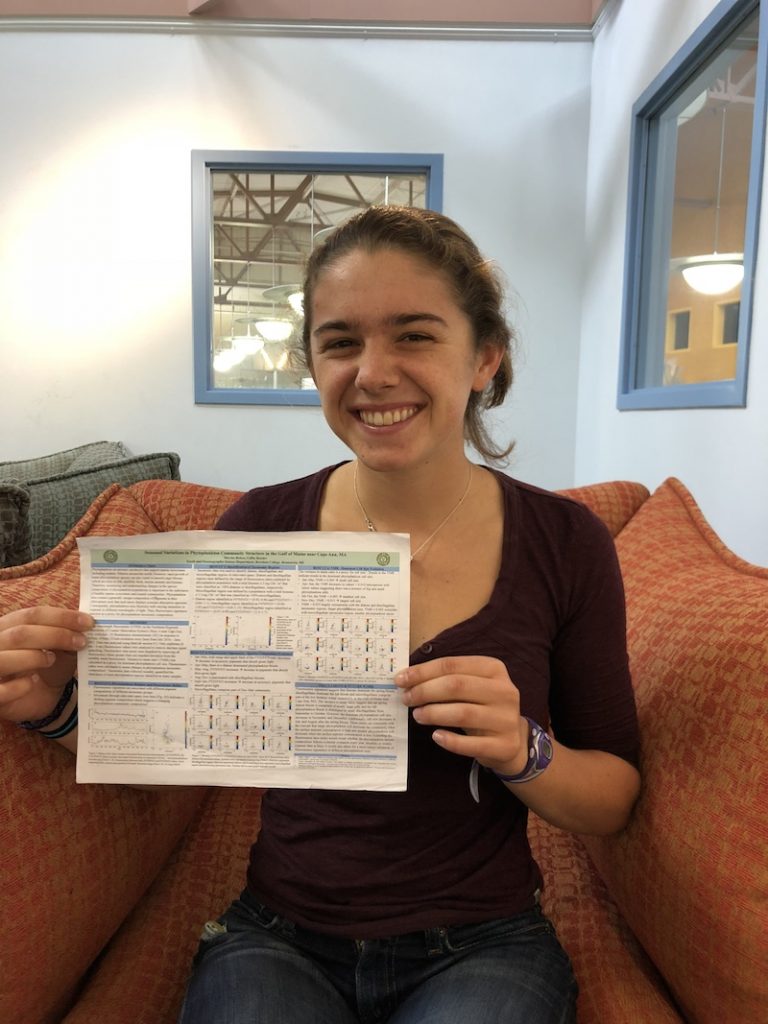Basking in Phytoplankton’s Glow: The Novel Marine Research of Martha Boben ’19
By Clayton Starr ’19
This summer, Martha Boben ’19 managed to ask big questions of some of the smallest creatures. With her Henry L. and Grace Doherty Coastal Studies Research Fellowship from Bowdoin, Boben studied a one-year dataset of phytoplankton off Cape Anne, Massachusetts.
Phytoplankton—the free-floating, photosynthetic organisms that produce half of Earth’s oxygen—sometimes flash, or fluoresce. As Boben explained, “Fluorescence is actually the way they give off energy.” Instead of sweating, phytoplankton glow.
Boben investigated what species of phytoplankton are living in the waters of Cape Anne throughout the year. To do this, she used data collected by the buoy of her faculty advisor, Collin Roesler, who is a professor of earth and oceanographic science.
“I talked to Collin about doing research in the summer, and I told her I was interested in changing species composition. I was really interested in how phytoplankton species structure would change in response to climate change. Collin said, ‘I have this dataset from Cape Anne that could be all yours.’”
Scientists around the world are interested in this question. Phytoplankton are the base of the oceanic food chain, and they sequester carbon dioxide from the atmosphere on the same scale as rainforests. If we hope to mitigate the greenhouse effect and maintain marine ecosystems, we have to understand the global and local population dynamics of phytoplankton—now more than ever.
The first step in Boben’s research was to find out which species are present in the phytoplankton community of Cape Anne as the seasons change. To do this, Boben looked at a year’s worth of fluorescence data.
Different species of phytoplankton have different pigments, and those pigments fluoresce most in response to different colors. Roesler’s buoy flashes blue, green, and blue-green light into the phytoplankton community and monitors what flashes back, giving researchers clues about what pigments—and therefore, what phytoplankton—are in the water.
Then it was up to Boben to sift through the buoy’s measurements (thirty-five per hour) and determine exactly what species are there and how big they are.
Gathering the data was just the start. Representing the results required more mental gymnastics for the earth and oceanographic sciences major (and math minor).
She drew up a number of graphs featuring the daily averages of fluorescence in response to blue and green light. She plotted that ratio and ended up with specific areas on her graph that correspond to specific phytoplankton.
“Different areas in the graph will represent different taxonomies. So you’ll have a diatom region, a dinoflagellate region, and you might have a microflagellate region or a cryptophyte region,” Boben said.
Through this call and response of light, Boben constructed Cape Anne’s phytoplankton community. She was able to reinforce her findings with physical evidence, because her collaborators took water samples every month and identified the species they found. Boben used those samples as cross-references for her graphs.
“For example, I would go to July and say it’s seventy percent diatoms, and all the data points are in this region [on the graph], so that’s probably a fluorescence signature for diatoms.”
“It’s a little confusing,” the senior added with a smile. “It’s a lot of levels.”
Carefully navigating these levels, Boben arrived at results that seemed to support her hypothesis.
“Generally, the spring bloom was dominated by diatoms and the fall bloom was dominated by dinoflagellates. The diatom bloom had larger cells and the dinoflagellate bloom had smaller cells, which is consistent with what you expect. In Intro Oceanography, you always talk about the diatom spring bloom, so that was the paradigm with which I entered this research.”
But Boben is thinking way past Introduction to Oceanography.
“The research is interesting because you could use fluorescence as a proxy for species composition, rather than going to take water samples. That would save you so much time, and you could have a much larger data set.”
So, instead of going out into the field in all weathers to collect water samples and then identifying phytoplankton under a microscope, scientists could learn what is out there with a few flashes of light. And they could take larger readings of the water column, too, all from the comforting glow of their computers.
“In the world of optical oceanography, this is a fairly new idea,” said Boben.